
Do Not Stand at My Grave and Weep, Mary Elizabeth Frye, American housewife and florist (1905
She was orphaned at the age of 3 and grew up to become a florist and housewife. She had never written a poem in her life but the obvious heartache of a young woman who stayed with her, prompted Frye to put pen to paper.
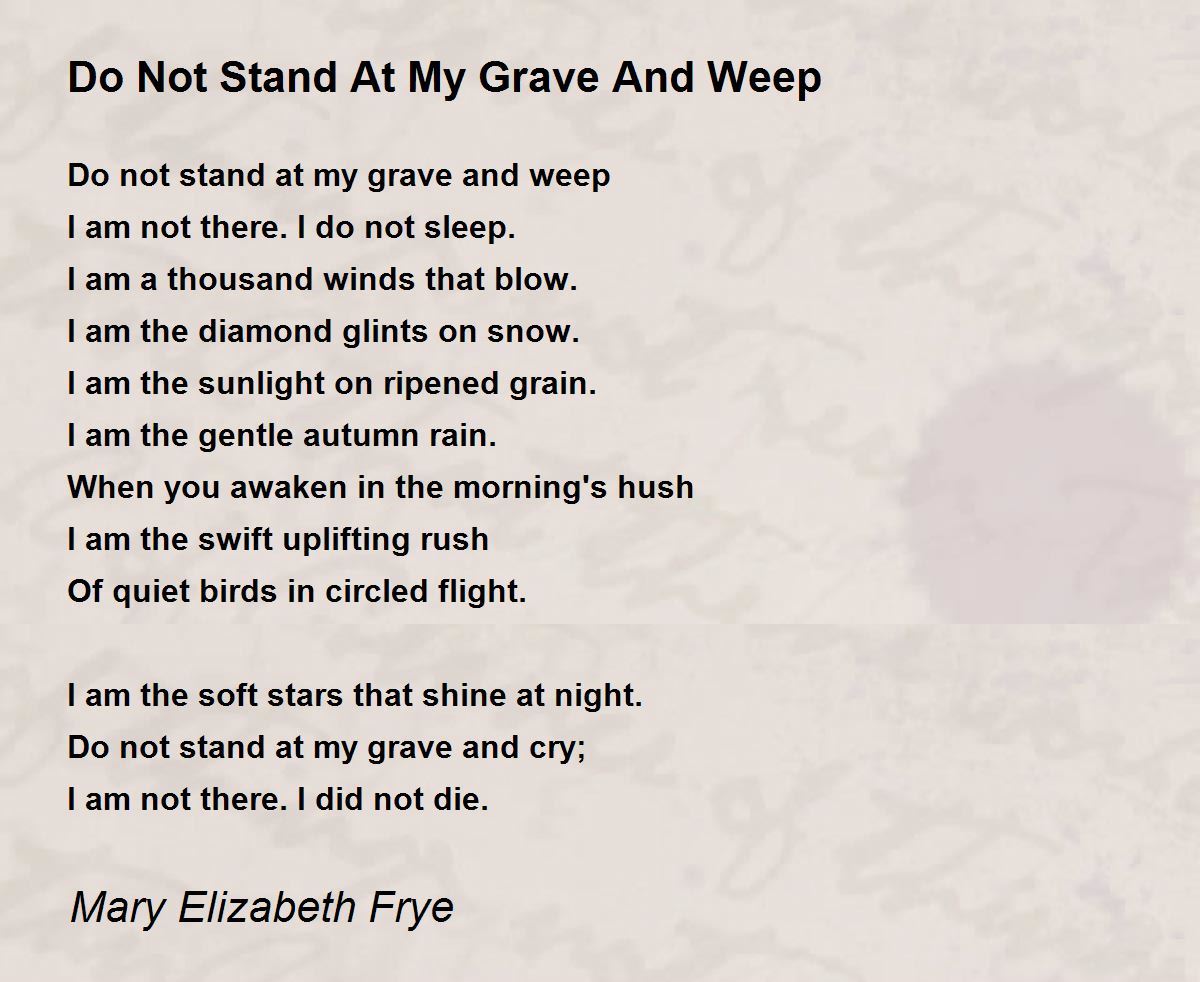
Do Not Stand At My Grave And Weep Poem by Mary Elizabeth Frye Poem Hunter
•4 min read The Most Celebrated Meditation on Death in Human History Philosophy WW In 1932, a woman named Mary Elizabeth Frye wrote a poem for the first time. She called it "Do Not Stand at My Grave and Weep." Little did she know, her poem was destined to touch the hearts and souls of millions of people.
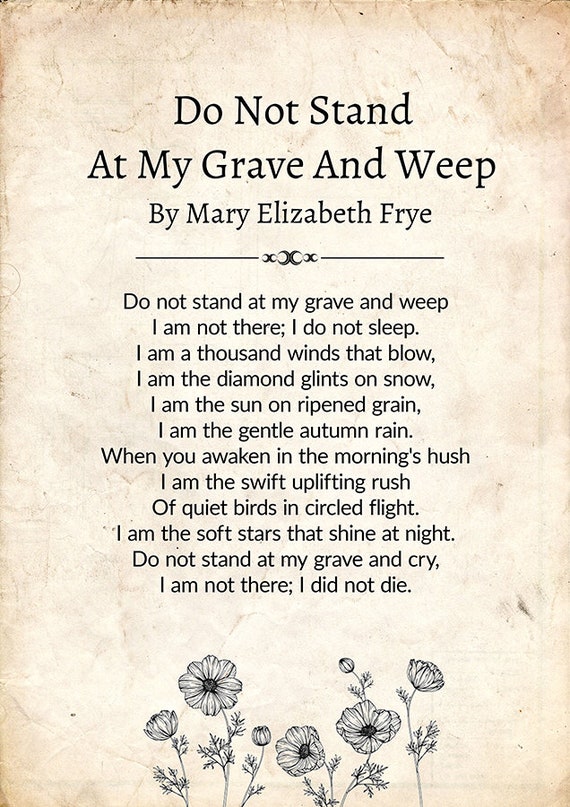
Do not stand at my grave and weep mary elizabeth frye glamdarelo
The poem "Do Not Stand at My Grave and Weep" is a call to action in 12 lines. It's composed of rhyming couplets in iambic tetrameter, though a few lines have extra syllables breaking up the structure to give extra emphasis. To understand what the poem by Mary Elizabeth Frye means, it's best to go line by line.

Do Not Stand At My Grave And Weep Memorial Poem By Mary Elizabeth Frye in 2022 Memorial poems
Mary Elizabeth Frye: Ne jöjj el sírva síromig. Ne jöjj el sírva síromig, Nem fekszem itt, nem alszom itt; Ezer fúvó szélben lakom Gyémánt vagyok fénylő havon, Érő kalászon nyári napfény, Szelíd esőcske őszi estén, Ott vagyok a reggeli csendben, A könnyed napi sietségben, Fejed fölött körző madár, Csillagfény sötét éjszakán,

√ Mary Elizabeth Frye Quotes And Poems
I am the sunlight on ripened grain. I am the gentle autumn rain. When you wake in the morning hush, I am the swift, uplifting rush. Of quiet birds in circling flight. I am the soft starlight at night. Do not stand at my grave and weep. I am not there, I do not sleep. (Do not stand at my grave and cry.

"A touching poem by Mary Elizabeth Frye Do not stand at my grave and weep (delicate text
A poem by Mary Elizabeth Frye Written by Mary Elizabeth Frye in the 1930's, 'Do Not Stand at My Grave and Weep' is a popular poem to be read at funeral services. Its words bring comfort to readers as it shows that the person who has died lives on in our memories.

Do Not Stand At My Grave And Weep By Mary Elizabeth Frye Famous Death Poem Sad Poem YouTube
Do not stand at my grave and weep, I am not there, I do not sleep. I am in a thousand winds that blow, I am the softly falling snow. I am the gentle showers of rain, I am the fields of ripening grain. I am in the morning hush, I am in the graceful rush. Of beautiful birds in circling flight,

Mary Elizabeth Frye Poet, Poetry, Picture, Bio, Elegy, Analysis Elegy, Poetry, Mary elizabeth
Mary Elizabeth Frye was an American housewife and florist, best known as the author of the poem Do not stand at my grave and weep, written in 1932. She was born in Dayton, Ohio, and was orphaned at the age of three. She moved to Baltimore, Maryland when she was twelve. She was an avid reader with a remarkable memory.
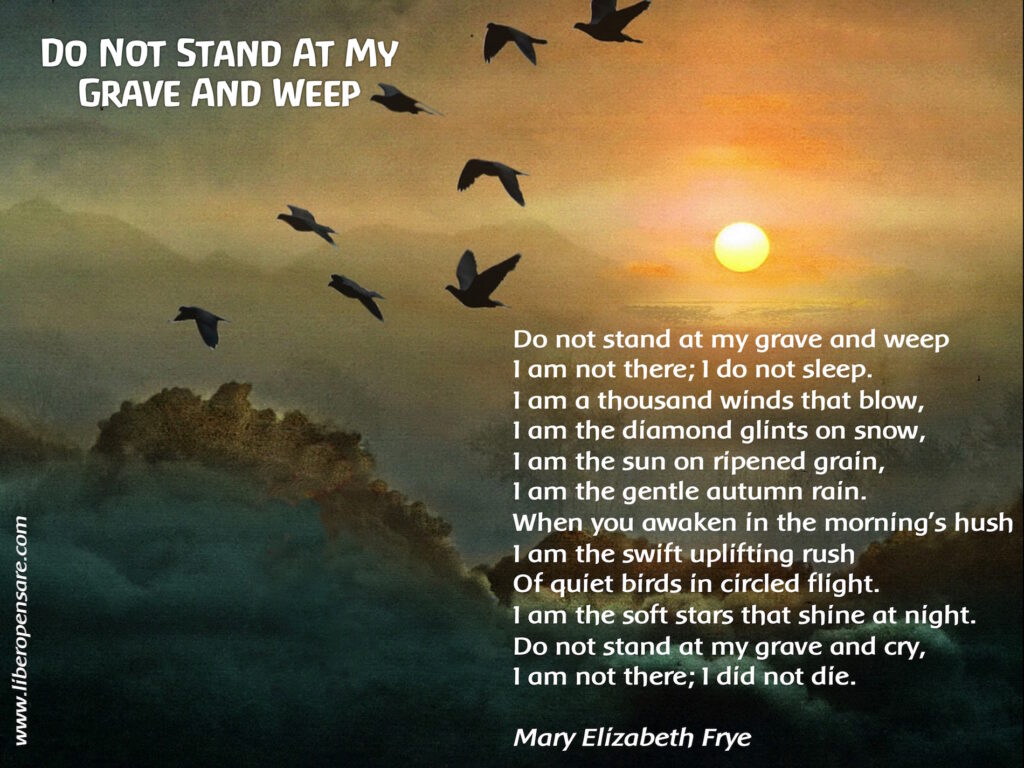
Do Not Stand At My Grave And Weep (Mary Elizabeth Frye)
Poems on Death Poems on sympathy Note on Authorship of poem The most widely circulated author is Mary Fry. The following was taken from The London Magazine December / January 2005: Mary Elizabeth Frye nee Clark was born in Dayton, Ohio, on November 13th 1905. She dies on September 15th 2004.

Poetry Print Mary Elizabeth Frye Do not Stand Poetry Wall Art Poem Print, Mary Elizabeth Frye
. Read Poem See Full List Mary Elizabeth Frye Biography a Baltimore housewife and florist, best known as the author of the poem "Do not stand at my grave and weep," written in 1932. She was born Mary Elizabeth Clark, and was orphaned at the age of three. In 1927 she married Claud Frye.

Poem Do Not Stand At My Grave And Weep; by Mary Elizabeth Frye Mary Elizabeth, Weeping, Frye
Do Not Stand at My Grave and Weep by Mary Elizabeth Frye, Paul Saunders (Illustrator) 4.52 avg rating — 264 ratings — published 1996 — 7 editions Want to Read Rate this book 1 of 5 stars 2 of 5 stars 3 of 5 stars 4 of 5 stars 5 of 5 stars * Note: these are all the books on Goodreads for this author. To add more, click here .
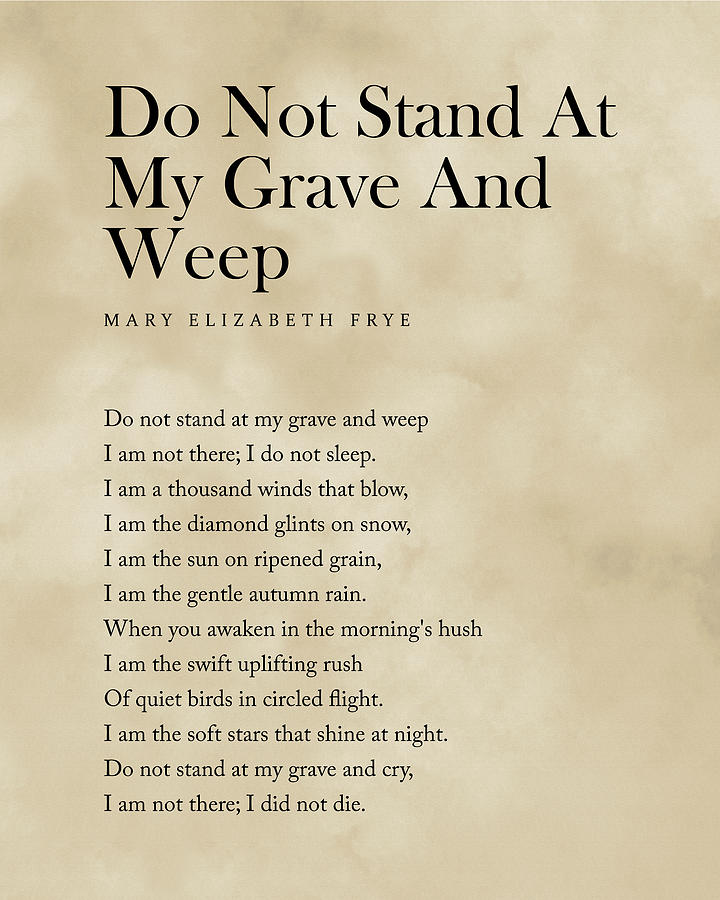
Do Not Stand At My Grave And Weep Mary Elizabeth Frye Poem Literature Typewriter Print 2
Mary Elizabeth Frye (1905-2004), a florist from Baltimore, MD claimed to have composed this poem in 1932 in a moment of inspiration to comfort a family friend who had just lost her mother and was unable to even visit her grave. However, the poem was only first formally published in the December 1934 issue of The Gypsy poetry magazine where it.

Do not stand at my grave and weep poem Mary Elizabeth Frye PRINTABLE print INTANT DOWNLOAD Art
How was the poem created? In 1932, a young Jewish girl from Germany, Margaret Schwarzkopf, stayed in Frye's house. Margaret's mother was ill in Germany, but she was afraid to visit her. Anti-Semitic unrest was increasing, so if Margaret had decided to go to Germany, she could have been imprisoned or killed.
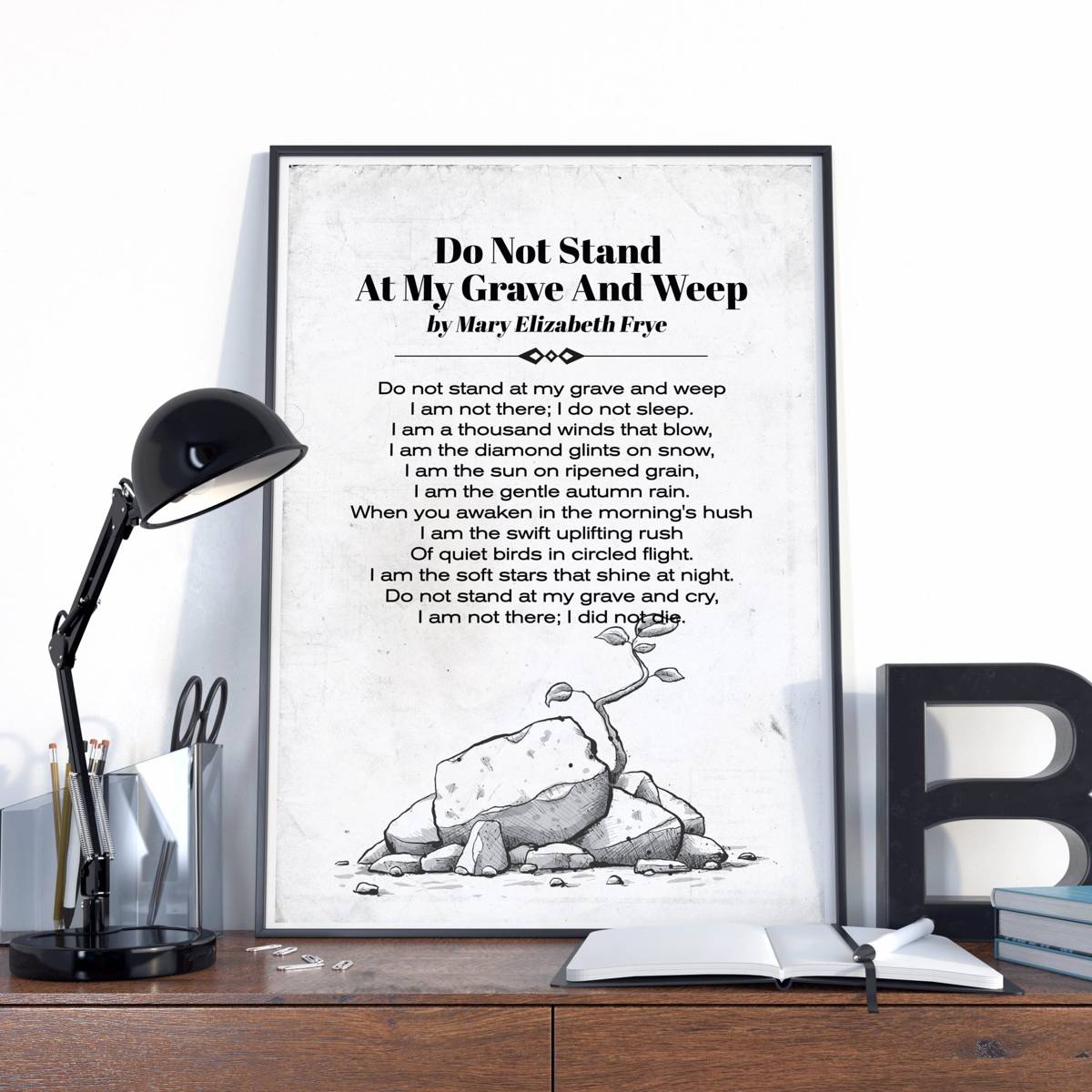
Do Not Stand At My Grave And Weep, Mary Elizabeth Frye Poem, Mary Elizabeth Frye Verse, Mary
The poem seems to function in three distinct parts: (1) I am not in my grave, so don't weep for me there. (2) Here are the encouraging places where you can continue to find me. (3) I reaffirm that I am not in my grave, nor am I dead, so don't weep for me there.
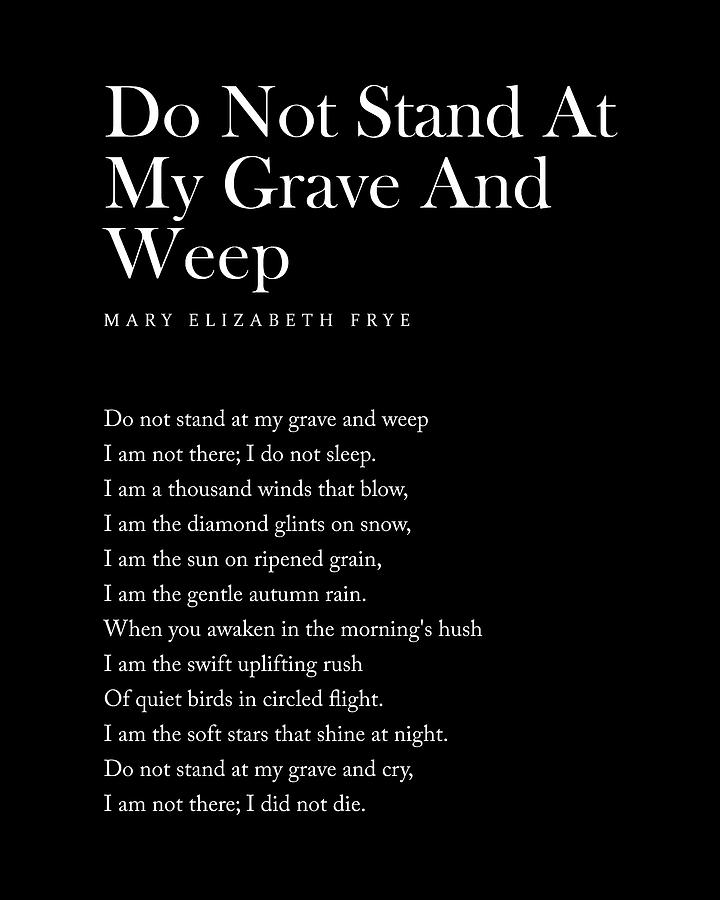
Do Not Stand At My Grave And Weep Mary Elizabeth Frye Poem Literature Typewriter Print 2
Mary Elizabeth Frye was an American housewife and florist, best known as the author of the poem Do not stand at my grave and weep, written in 1932. She was born in Dayton, Ohio, and was orphaned at the age of three. She moved to Baltimore, Maryland, when she was twelve. She was an avid reader with a remarkable memory.

This beautiful poem by Mary Elizabeth Frye was read out at both my great grandmother and great
Mary Frye is an American poet best known for the piece 'Do Not Stand at My Grave and Weep.'. She was born on November 13, 1905 in Dayton. In this touching poem, 'Do Not Stand at My Grave and Weep', by Mary Frye, she speaks of death in a welcoming tone. She offers words of comfort for those who would mourn for her at her passing, and she.